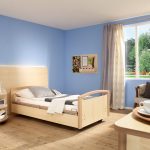Passive mattresses are particularly suitable for the care of residents who need to spend most of the day in bed. The quality of the materials, the processing and the technical features should meet the high standards of care in hospitals as well as care facilities. These products typically use different materials, some of which we would like to explain in more detail below:
Polyether foam (PU)
PU refers to foams that quickly return to their original position after deformation. They have a high elasticity and provide good supporting power.
Cold foam
This material has a higher elasticity than PU foam. Due to its open porosity, it has a better material quality. The open cells provide air permeability and a comfortable sleeping environment.
Viscoelastic foam
This foam is often referred to as „memory foam“. He responds to body heat and body pressure. This causes a slight sinking into the mattress and an optimal adaptation to the individual body contours. The resulting pressure relief makes mattresses of viscoelastic foam the best choice for decubitus prophylaxis.
Important sizes for mattrasses
In assessing the quality of passive mattresses in particular 2 sizes are of crucial importance:
Volumetric weight (VW) is an essential quality indicator for mattresses. It indicates how many kilograms of foam are processed per cubic meter.
Example: VW 60 = 60 kilograms per cubic meter. So the higher the volume weight, the higher the durability of the mattress.
The compressive strength indicates the strength of the foam. It describes the pressure required to depress the foam by 40%. The unit of measure is kilopascal (kPa). The higher the compression hardness, the harder the foam.
CliniCare 30 from wissner-bosserhoff
A good example of a high-quality mattress is the CliniCare 30 from wissner-bosserhoff. It is a special viscoelastic mattress with a height of 14 cm. The top consists of viscoelastic thermal foam with a specially developed climate layer. This distributes the body heat evenly over the entire lying surface. This will do that Reduced sweating and made a significant contribution to decubitus prophylaxis.


